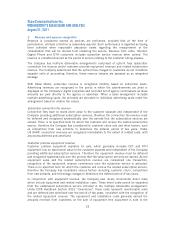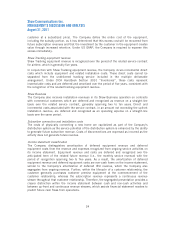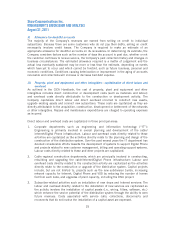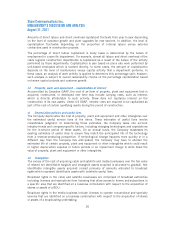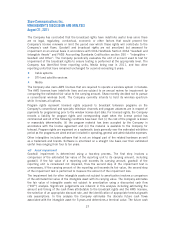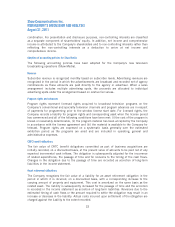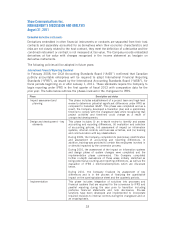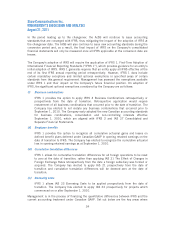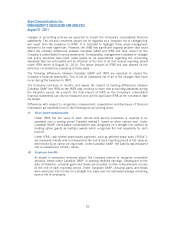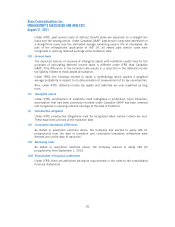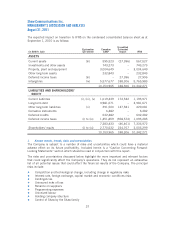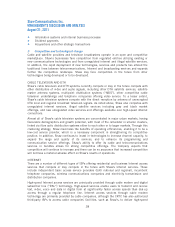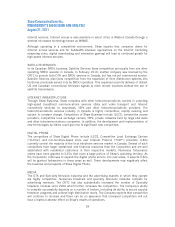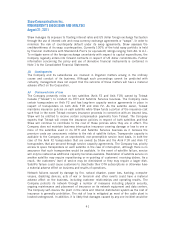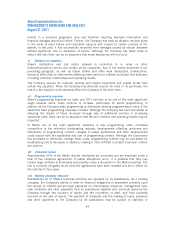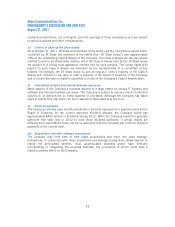Shaw 2011 Annual Report Download - page 37
Download and view the complete annual report
Please find page 37 of the 2011 Shaw annual report below. You can navigate through the pages in the report by either clicking on the pages listed below, or by using the keyword search tool below to find specific information within the annual report.
Shaw Communications Inc.
MANAGEMENT’S DISCUSSION AND ANALYSIS
August 31, 2011
Embedded derivative instruments
Derivatives embedded in other financial instruments or contracts are separated from their host
contracts and separately accounted for as derivatives when their economic characteristics and
risks are not closely related to the host contract, they meet the definition of a derivative and the
combined instrument or contract is not measured at fair value. The Company records embedded
derivatives at fair value with changes recognized in the income statement as loss/gain on
derivative instruments.
The following policies will be adopted in future years:
International Financial Reporting Standards
In February 2008, the CICA Accounting Standards Board (“AcSB”) confirmed that Canadian
publicly accountable enterprises will be required to adopt International Financial Reporting
Standards (“IFRS”), as issued by the International Accounting Standards Board (“IASB”), for
fiscal periods beginning on or after January 1, 2011. These standards require the Company to
begin reporting under IFRS in the first quarter of fiscal 2012 with comparative data for the
prior year. The table below outlines the phases involved in the changeover to IFRS.
Phase Description and status
Impact assessment and
planning
This phase includes establishment of a project team and high-level
review to determine potential significant differences under IFRS as
compared to Canadian GAAP. This phase was completed and as a
result, the Company developed a transition plan and a preliminary
timeline to comply with the changeover date while recognizing that
project activities and timelines could change as a result of
unexpected developments.
Design and development – key
elements
This phase includes (i) an in-depth review to identify and assess
accounting and reporting differences, (ii) evaluation and selection
of accounting policies, (iii) assessment of impact on information
systems, internal controls, and business activities, and (iv) training
and communication with key stakeholders.
During 2009, the Company completed its preliminary identification
and assessment of accounting and reporting differences. In
addition, training was provided to certain key employees involved in
or directly impacted by the conversion process.
During 2010, the assessment of the impact on information systems
and design phase of system changes were completed and the
implementation phase commenced. The Company completed
further in-depth evaluations of those areas initially identified as
being potential accounting and reporting differences, as well as the
evaluation of IFRS 1 elections/exemptions which are discussed
below.
During 2011, the Company finalized its assessment of key
differences and is in the process of finalizing the quantitative
impact on the opening balance sheet and the quarterly periods.
Implementation This phase includes integration of solutions into processes and
financial systems that are required for the conversion to IFRS and
parallel reporting during the year prior to transition including
proforma financial statements and note disclosures. Process
solutions have been developed and implemented to incorporate
required revisions to internal controls during the changeover and on
an on-going basis.
33


